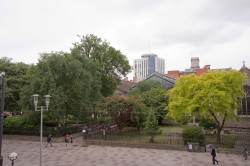Background
 The provision of green space in urban areas can make a positive contribution to improving the quality of the urban landscape. Landscape quality can encompass many elements including environmental pollution and cleanliness, visual and aesthetic quality and perception of personal security.
The provision of green space in urban areas can make a positive contribution to improving the quality of the urban landscape. Landscape quality can encompass many elements including environmental pollution and cleanliness, visual and aesthetic quality and perception of personal security.
As urban areas become increasingly developed there is the need to implement and manage green space in order to contribute to a town or city’s image. A pleasant and well-maintained environment can attract companies to an area which can in turn attract visitors and improve people’s enjoyment of an area. The economic benefits of improved landscape quality from green space provision can be quantified through increased house prices, investment and land value.
Opportunities and issues
The economic value of improved aesthetics and landscape quality in monetary terms can be estimated through people’s ‘willingness to pay’ for goods and services in an area, however there is weakness in this approach as this gives little insight into the combined value of more than one improvement.
Also, across England there is an ongoing struggle to find capital funding for investment in green infrastructure and also to find funding to maintain these areas to a high standard. Areas of green space that are not sufficiently maintained will fall into disrepair and attract acts of vandalism and graffiti.
Practical considerations
It is important to:
- Consult local people on the design of urban green space to ensure developments are suitable for the area, and to create empowerment and community cohesion
- Secure funding to maintain local green spaces to a high standard
- Increase the availability of accessible green space to priority populations in order to regenerate deprived areas
- Monitor green space quality and carrying out user perception surveys to ensure future ventures are carried out appropriately.
Case studies
Benefits of green infrastructure case studies:
- Improving quality of place. Ingrebourne Hill Community Woodland(PDF-2230K)
- Improving quality of place. Newlands Green Streets(PDF-122K)
- Increasing environmental quality and aesthetics. Moston Vale, Manchester (PDF-72K)
- Increasing environmental quality and aesthetics. Glasgow Green Park: transformation to attractive green space (PDF-141K)
Services
Forest Research has developed Methuselah: A Monitoring and evaluation strategy for Greenspace (PDF-870K) as a monitoring and evaluation strategy for the provision of green space.
Further information
- Increasing environmental quality and aesthetics (PDF-41K)
Benefits of green infrastructure evidence note - Improving quality of place (PDF-43K)
Benefits of green infrastructure evidence note - Benefits of green infrastructure – summary report (PDF-2330K)
- Benefits of green infrastructure – main report (PDF-1180K)
